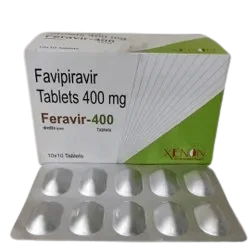Description
Feravir 400 mg
Overview
Feravir 400 mg contains Favipiravir, an antiviral drug used primarily in the treatment of mild to moderate COVID-19 and influenza virus infections. It is part of the pyrazinecarboxamide class and works by inhibiting viral RNA polymerase, thereby preventing the replication of RNA viruses.
Key Details
- Generic Name: Favipiravir
- Strength: 400 mg per tablet
- Form: Oral tablet
- Category: Antiviral medication
- Prescription Required: Yes
Dosage & Administration
- Loading dose (Day 1): 1800 mg twice daily
- Maintenance dose (Day 2–5): 800 mg twice daily
- Dosage may vary based on medical condition and physician recommendation
- Take orally with water, preferably after meals
Side Effects
- Nausea or vomiting
- Diarrhea
- Elevated liver enzymes
- Increased uric acid levels (hyperuricemia)
- Possible rash or mild allergic reaction
- Teratogenic risk – contraindicated in pregnancy
Precautions
- Not for use in pregnant or breastfeeding women
- Caution in patients with liver disease, kidney impairment, or gout
- Periodic monitoring of liver function and uric acid is recommended
- Keep out of reach of children
- Store at room temperature, away from moisture and heat
FAQs
- Q1: What is Feravir 400 mg used for?
- A: It is used for treating mild to moderate COVID-19 and influenza virus infections in specific regions where it is approved or authorized for emergency use.
- Q2: Is Feravir 400 mg safe during pregnancy?
- A: No. It is contraindicated in pregnancy due to potential fetal harm.
- Q3: How is Feravir 400 mg different from the 200 mg version?
- A: It contains a higher concentration of Favipiravir, allowing for fewer tablets per dose and potentially improved compliance for loading and maintenance phases.
- Q4: Can it be self-prescribed?
- A: No. It must be taken under medical supervision with a valid prescription.
- Q5: How quickly does it start working?
- A: Symptomatic relief may begin within 24–72 hours after starting treatment, depending on the viral load and patient’s immune response.





